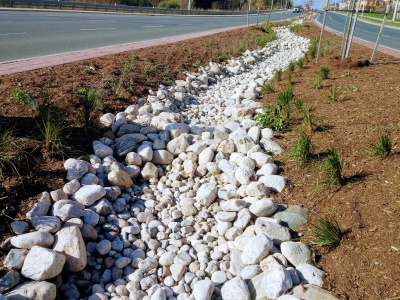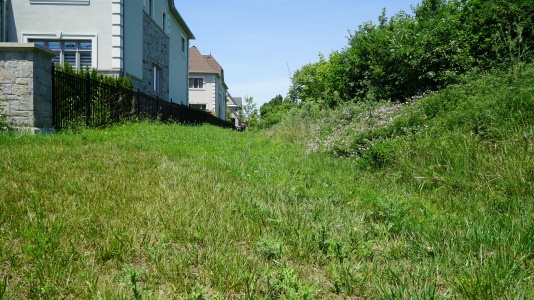Bioswales
This article is about installations designed to capture and convey surface runoff along a vegetated channel, whilst also promoting infiltration.
For underground conveyance which promotes infiltration, see Exfiltration trenches.
For design recommendations on grassed channels, see Enhanced grass swales.
Overview[edit]
The fundamental components of a bioswale are:
- A graded channel
- Planting
- Filter media, to permit infiltration into the facility (not necessarily to soils below)
Additional components may include:
- Underdrain with clean out and inspection ports
- Impermeable membrane to prevent infiltration to soils below
- Check dams to facilitate short tern ponding
Planning considerations[edit]
Design[edit]
Bioswales are sized as narrow linear bioretention cells. Drainage time of bioswales are typically lower than other geometric configurations of similarly sized bioretention facilities, owing to the higher hydraulic radius of the sides.
Materials
Bioretention: Planting design Bioretention: Plant list
Gallery[edit]
Streetside swale in Seattle
This feature is a bioswale in that the underlying soil has been replaced with engineered filter media. The turf finish simplifies landscape maintenance. Brampton, ON
Performance[edit]
While few field studies of the pollutant removal capacity of bioswales are available from cold climate regions like Ontario, it can be assumed that they would perform similar to bioretention cells. Bioretention provides effective removal for many pollutants as a result of sedimentation, filtering, plant uptake, soil adsorption, and microbial processes. It is important to note that there is a relationship between the water balance and water quality functions. If a bioswale infiltrates and evaporates 100% of the flow from a site, then there is essentially no pollution leaving the site in surface runoff. Furthermore, treatment of infiltrated runoff will continue to occur as it moves through the native soils.
| Design | Location | Runoff reduction |
|---|---|---|
| No underdrain | Washington[1] | >98 % |
| No underdrain | United Kingdom | >94 % |
| With underdrain | Maryland[2] | 46 - 54 % |
| Runoff reduction estimate | 85 % | |
- ↑ Horner RR, Lim H, Burges SJ. HYDROLOGIC MONITORING OF THE SEATTLE ULTRA-URBAN STORMWATER MANAGEMENT PROJECTS: SUMMARY OF THE 2000-2003 WATER YEARS. Seattle; 2004. http://citeseerx.ist.psu.edu/viewdoc/download?doi=10.1.1.365.8665&rep=rep1&type=pdf. Accessed August 11, 2017.
- ↑ https://www.pca.state.mn.us/sites/default/files/p-gen3-14g.pdf



